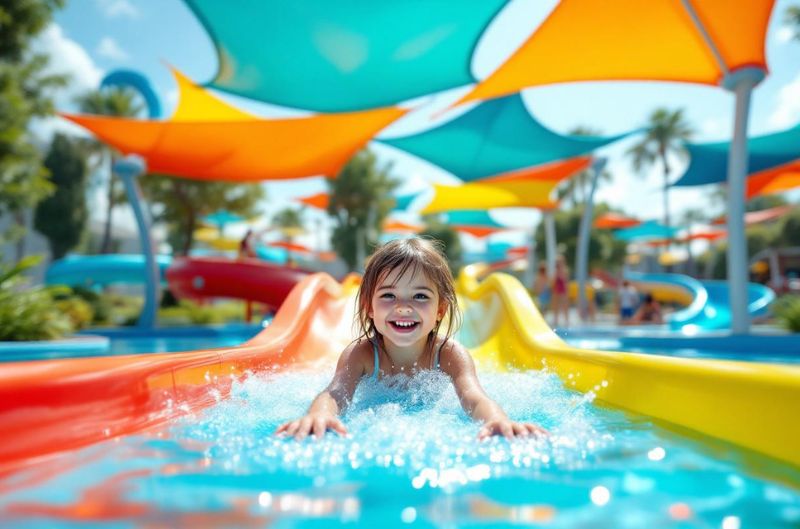
How Shade, Cooling, and Water Play Are Becoming Essentials
Author: Austin Stanfel
Shade, cooling elements, and water play are no longer just nice-to-have features in playgrounds and public recreational spaces – they are rapidly becoming essential components in modern, climate-conscious design. Rising global temperatures, shifting weather patterns, and increasing awareness of children’s health and comfort are driving communities, designers, and municipalities to rethink how outdoor play environments are equipped to deal with heat.
The Rise of Climate-Adaptive Playgrounds
In decades past, playground planners primarily focused on a variety of equipment, safety, and accessibility. While these remain critical, today’s realities require an additional layer of design considerations: protection from excessive heat. With more frequent heatwaves and extended summer seasons, playgrounds without mitigation strategies face reduced usability, potential safety issues, and increased risk of heat-related illnesses for children.
Parents, educators, and city planners are recognizing that without shade structures, cooling zones, and water features, public play spaces can quickly become too hot to enjoy for much of the year. This concern has shifted shade, cooling, and water play from conveniences to necessities.
Shade as a Design Priority
Shade is the first line of defense against the sun’s intensity. Modern playgrounds integrate shade through a combination of natural and structural approaches.
- Fabric Shade Canopies: UV-resistant fabrics stretched over play zones can block up to 95% of harmful ultraviolet radiation. Their versatility in terms of shapes and colors also allows for aesthetic integration into themed or modern playground designs.
- Steel Shade Structures: More permanent and durable solutions, often used in commercial playgrounds, that provide long-term coverage and withstand harsher weather conditions.
- Natural Landscaping: Strategically planted trees and shrubs not only cool the space but also introduce biodiversity, encourage interaction with nature, and enhance aesthetics.
- Integrated Equipment Shade: Modern play equipment often includes built-in roofs or overhangs to keep slides, climbing surfaces, and seating areas cooler.
Adding shade is not only a comfort factor; studies link shaded play environments to play sessions longer, reduced equipment surface temperatures, and greater overall accessibility for children who are heat-sensitive.
Cooling Zones for Active Comfort
Beyond shade coverage, active cooling systems are increasingly common in community playground designs. These spaces bring down ambient temperatures and encourage extended play.
- Misting Stations: Low-flow misting poles or arches that spray fine cool water into the air, lowering the temperature in specific zones while offering quick refreshment.
- Cooling Pavilions: Semi-enclosed rest areas with fans, ventilation systems, and hydration points, placed near active play areas.
- Temperature-Controlled Seating: Benches made from materials less prone to heat absorption or positioned under shaded areas for comfortable resting spots.
In urban environments, where cooling breezes are limited and surfaces can trap heat, these zones can make play possible even during peak midday hours.
The Surge of Water Play Features
Water play is one of the most engaging and effective ways to keep children cool while promoting sensory-rich play experiences. Unlike traditional playground equipment, it actively counteracts elevated temperatures while encouraging imaginative exploration.
- Splash Pads: Flat, non-slip surfaces with safe, pressurized jets that shoot water at varying intervals for interactive fun.
- Interactive Water Sculptures: Play towers, tipping buckets, and spinning water wheels introduce engineering concepts and cause-and-effect learning through play.
- Shallow Wading Areas: Designed with strict safety parameters, these spaces allow toddlers and preschoolers to engage in safe aquatic play.
- Eco-Conscious Designs: Water recycling systems and timed sprays conserve resources while maintaining optimal cooling benefits.
Water play also supports child development through tactile engagement, problem-solving during cooperative games, and social skills fostered in shared play environments.
Why These Features Are Essential
Several driving forces solidify shade, cooling, and water play as necessities:
- Health & Safety: Reduces the risk of dehydration, sunburn, and heat stroke.
- Year-Round Usability: Extends playground use beyond cooler months, keeping spaces active and accessible.
- Inclusivity: Ensures children with medical conditions or higher heat sensitivity can participate without limitations.
- Community Satisfaction: Parents are more likely to visit and stay longer in playgrounds equipped for comfort.
- Adaptation to Climate Trends: Playgrounds designed with environmental resilience are better equipped to withstand future temperature extremes.
Designing the Future of Play
Forward-thinking playground designs seamlessly combine all three elements. A fully climate-adaptive play space might include:
- Tree-lined perimeter for natural shade.
- Central-themed play structures protected by fabric canopies.
- A dedicated water play zone with eco-friendly management systems.
- Cooling rest hubs with hydration stations.
- Materials chosen for low heat retention in flooring and seating.
The result is a safe, inclusive, and enjoyable space that acknowledges climate realities while preserving the joy of outdoor play.
Shade, cooling, and water play have transitioned from optional features to critical infrastructure in modern playground planning. Communities investing in these solutions are future-proofing their public spaces and ensuring play remains an essential part of childhood—even in hotter global conditions.

